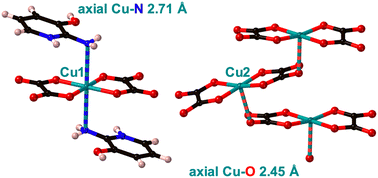Synthesis, structure and magnetic properties of two bis(oxalato)cuprate(ii) salts with pyridinium type counter ions†
Abstract
Mono- and a di-protonated pyridine type cations have been used for the synthesis of two bis(oxalato)cuprate(II) salts, namely, (C5H7N2O)2[Cu(C2O4)2] (C5H7N2O = 2-amino-3-hydroxypyridinium) 1 and C13H16N2[Cu(C2O4)2] (C13H16N2 = 4,4′-trimethylenedipyridinium) 2. In the crystal structures, C2O42− adopts different coordination modes: the common bidentate chelating oxalate in 1 and the relatively scarce μ-oxalato-κ3O1,O2:O1′ in 2. X-ray diffraction also revealed that [Cu(C2O4)2]2− anions do not polymerize in 1 (a phenomenon hardly observed in such salts), while in 2, the polymerization of [Cu(C2O4)2]2− units occurs via the Cu–Oaxial contact forming a zigzag Cu(II) chain. In complex 1, the emerging building blocks are linked into 2D supramolecular layers via N–H⋯O and O–H⋯O hydrogen bonds and weaker C–H⋯O interaction to form a 3D net. In contrast to 2, the emerging building blocks are linked into 1D chains via N–H⋯O hydrogen bonds, which further extend to form a 3D supramolecular framework through Cu–Oaxial and other C–H⋯O interactions. The structural diversities show that iminium counterions play key roles in the construction of various architectures. Thermal analyses showed no weight loss for either system in the temperature range of 20–180 °C, which indicates that none of these complexes possess solvation water molecules. Magnetic studies indicate the presence of antiferromagnetic coupling between the spin centres in 1 and 2.

- This article is part of the themed collections: Crystal Engineering in Africa and Introducing the CrystEngComm Advisory Board and their research


 Please wait while we load your content...
Please wait while we load your content...